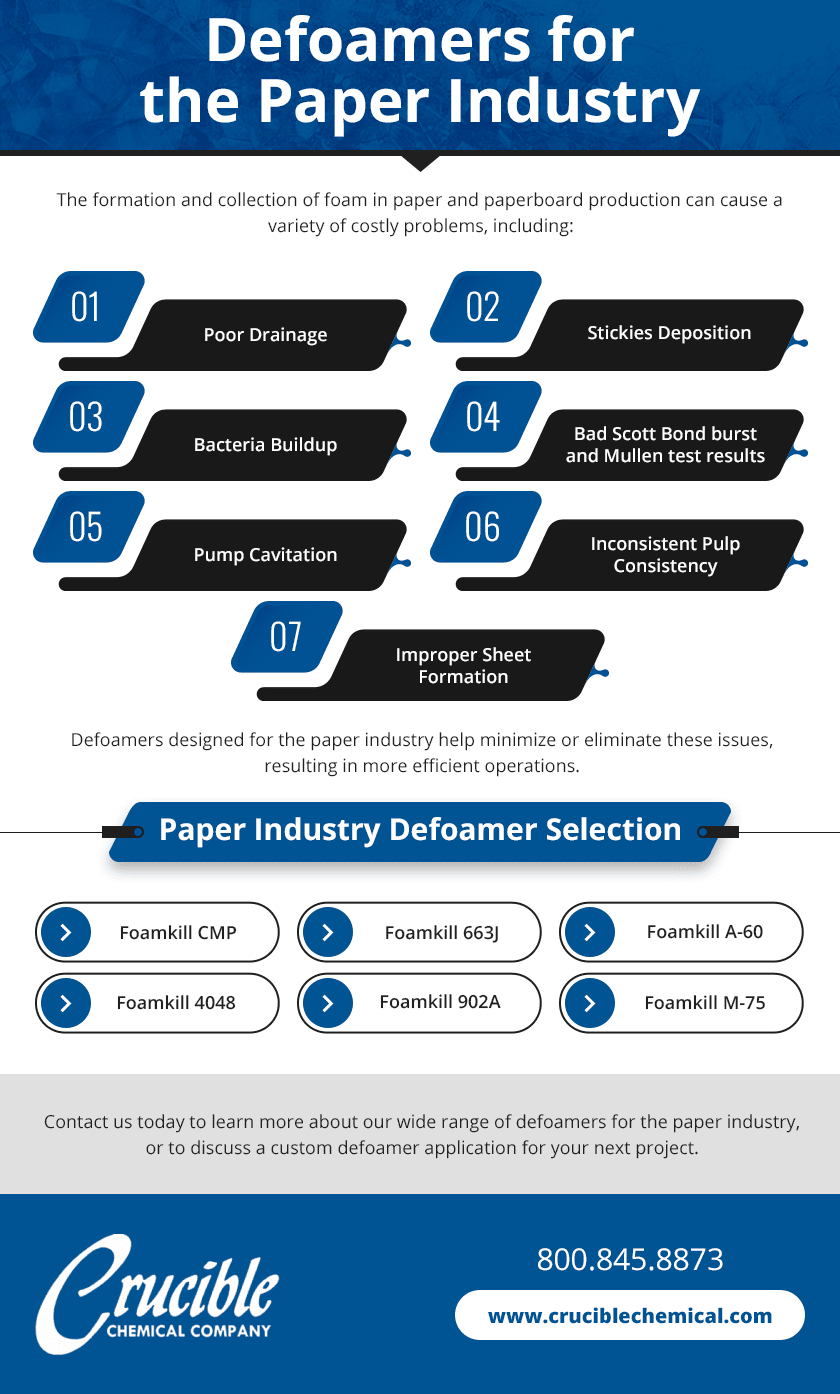The Role of Defoamers in the Chemical and Food Processing Industries
The Function of Defoamers in Enhancing Product Top Quality and Performance
Defoamers offer as essential additives that reduce this issue, making certain smoother manufacturing process while boosting the visual and useful attributes of the last products. The choice of the appropriate defoamer can be crucial to achieving optimum outcomes, raising essential inquiries regarding formula compatibility and efficiency metrics that merit further expedition.
Comprehending Defoamers
Recognizing the function of defoamers is vital for maintaining product high quality across different markets. Defoamers are chemical ingredients designed to minimize and avoid the formation of foam in fluid systems, which can negatively affect processes such as mixing, filling up, and surface area tension. Foaming can lead to inadequacies, product problems, and compromised visual charm, making defoamers a critical component in producing procedures.
In industrial applications, defoamers aid to enhance product uniformity and security. The effective usage of defoamers not only ensures smoother production processes yet additionally contributes to remarkable product performance.
In addition, the choice and solution of a defoamer need to straighten with particular application needs, such as compatibility with various other active ingredients, effectiveness under differing temperature and pH conditions, and possible regulative restrictions. Ultimately, recognizing defoamers' features and their significance in numerous formulas is essential for enhancing production and making certain the best quality end items.
Types of Defoamers
Defoamers can be categorized right into several kinds based on their composition and system of action. The main types consist of silicone-based, non-silicone natural, and inorganic defoamers.
Silicone-based defoamers are amongst the most effective, mostly as a result of their ability to spread rapidly on the liquid surface and disrupt foam formation. Their one-of-a-kind chemical structure permits premium security, making them ideal for high-temperature applications and environments with varying pH degrees.
Non-silicone natural defoamers, usually made up of fatty acids or all-natural oils, are valued for their biodegradability and lower poisoning. These are commonly made use of in food and beverage applications where security and ecological influence are extremely important.
Not natural defoamers, that include materials like talc or calcium carbonate, act by increasing the thickness of the fluid, consequently lowering foam security. They are commonly made use of in industrial procedures where compatibility with various other products is not a worry.
Each sort of defoamer has unique benefits and constraints, permitting tailored options depending on the details foaming problems encountered in different applications. Comprehending these distinctions is critical for enhancing performance and accomplishing wanted product top quality.
Applications Across Industries
Countless markets leverage defoamers to boost item high quality and functional efficiency. In the food and drink market, defoamers are critical in processes such as brewing and dairy products manufacturing to avoid foam development, which can result in inadequacies and product incongruity. By controlling foam, makers can make certain much better yield and a more uniform item.
In the pharmaceutical industry, defoamers play an important duty in the formulation of fluid medicines, where extreme foam can hamper blending and precise application. Their use aids keep the stability of the formulations and promotes smoother manufacturing processes.
The paint and coatings industry additionally counts on defoamers to boost the performance of items throughout application. By lessening foam, these ingredients make sure a smoother finish and boost the visual qualities of the last product.

Benefits of Using Defoamers
While the application of defoamers varies across markets, their benefits continually boost product high quality and procedure efficiency. One significant benefit is the decrease of foam development during manufacturing procedures, which can or else lead to manufacturing hold-ups and variances in product quality. By decreasing foam, defoamers make it possible for a smoother circulation of materials, facilitating a lot more efficient procedures and lowering the possibility of equipment breakdowns.
Furthermore, the use of defoamers can improve the look and appearance of end products. In markets such as finishes, paints, and food handling, extreme foam can endanger the aesthetic aesthetic appeals and total top quality, while the ideal defoamer application makes certain a consistent finish and desirable characteristics. Additionally, defoamers can add to set you back savings by reducing waste during production and optimizing using resources (defoamers).

Choosing the Right Defoamer
Choosing the right defoamer is crucial for optimizing production procedures and guaranteeing item top quality. The choice of defoamer affects not only the efficiency of foam control but additionally the general efficiency characteristics of the final item. Elements to take into consideration consist of the sort of application, the chemistry of the formulation, and the ecological conditions under which the item will certainly be made use of.
Various sectors might need particular defoamer types, such as silicone-based, natural, or polymeric defoamers. Understanding the compatibility of the defoamer with the primary components is important to avoid unfavorable responses that can endanger product integrity. In addition, the defoamer's performance in various temperatures and pH degrees must be examined to make certain constant performance.
Checking the defoamer in small-scale applications can offer useful understandings into its efficiency and viability. Consideration of regulative conformity, especially in food, pharmaceuticals, and cosmetics, is paramount in selecting a defoamer. Eventually, a comprehensive evaluation of these variables will certainly cause the option of a defoamer that not only regulates foam successfully but likewise enhances the high quality and performance of the last product.
Final Thought

Finally, defoamers are important ingredients that significantly improve product quality and efficiency across different industries. By efficiently reducing foam development, these agents not just enhance operational effectiveness but likewise add to the functional and visual integrity of items. my latest blog post The critical option and application of defoamers bring about set you back savings, optimized resource usage, and boosted customer satisfaction. Overall, the significance of defoamers in industrial processes can not be overstated, as they play an essential function in achieving top quality and consistent end results.
Frothing can lead to inefficiencies, product problems, and jeopardized aesthetic allure, making defoamers a vital element in manufacturing procedures.
